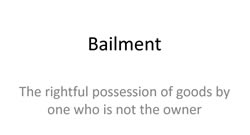Difference between Sale and Bailment
Key difference: Sale and Bailment are two different types of contracts. A contract of sale is a straight forward contract where a person may buy goods, services or property from a seller in exchange for remuneration, usually in the form of money. Essentially, in abailment contract, the bailor gives the goods, assets or property to the bailee for a specific amount of time. However, the goods, assets or property still belongs to the bailor.
 Sale and Bailment are two different types of contracts. A contract of sale is a straight forward contract where a person may buy goods, services or property from a seller in exchange for remuneration, usually in the form of money. This amount is decided between the buyer and seller as appropriate for the value of goods, services or property.
Sale and Bailment are two different types of contracts. A contract of sale is a straight forward contract where a person may buy goods, services or property from a seller in exchange for remuneration, usually in the form of money. This amount is decided between the buyer and seller as appropriate for the value of goods, services or property.
Bailment, on the other hand is slightly different than sale. The definition of 'Bailment' states that it is “the contractual transfer of possession of assets or property for a specific objective. In bailment, the deliverer of the asset is the bailor, and the receiver is the bailee. In a bailment transaction, ownership is never transfered, and the bailor is generally not entitled to use the property while it's in possession of the bailee. In these ways, bailment differs from gifting and leasing.”
Investopedia explains 'Bailment' as “Bailment is a legal relationship between two parties, whereby the owner retains full rights to the assets or property but the possesses the property. For example, when a bank holds a borrower's asset as collateral for a secured loan, this is a form of bailment. In this case, the bank is the bailee and the borrower is the bailor.”

Essentially, in a bailment contract, the bailor gives the goods, assets or property to the bailee for a specific amount of time. However, the goods, assets or property still belongs to the bailor. The bailee just has the possession of the goods for the time being. The bailee may not however use the asset any way he likes, it must be used as the bailor instructed. The bailor may also give the assets to the bailee for safekeeping. After the agreed upon time is passed, the bailee must return the procession of the goods, assets or property back to the bailor.
Detailed comparison between Sale and Bailment:
|
|
Sale |
Bailment |
|
Possession |
Possession of goods is transferred to the buyer. |
Possession of goods is transferred to the bailee. |
|
Ownership |
Ownership is transferred to the buyer. |
Ownership resides with the bailor. |
|
Usage |
The buyer may use the goods in any way he likes. |
A bailee can use the goods only according to the directions of the bailor. |
|
Return |
There is no return of goods from the buyer to the seller, unless there is breach. |
The goods are returned after the specified time or accomplishment of the purpose. |
|
Consideration |
The consideration is the price in terms of money. |
The consideration is an undertaking to return the goods after the accomplishment of the purpose. |
|
Charges |
The question of any charges to be paid by the seller to buyer or vise versa does not arise. |
The bailor has to repay the charges which the bailee has incurred in keeping the goods safe. |
|
Duration |
Final. Once the sale is transacted, the seller keeps the goods until he decides to sell them to another. |
Temporary. The bailee has to return the goods to the bailor once the specified time is passed. |
Image Courtesy: suffolktradingstandards.files.wordpress.com, docstoc.com









Comments
Thanks alot..its really useful
Pam
Sun, 05/10/2015 - 09:43
Add new comment